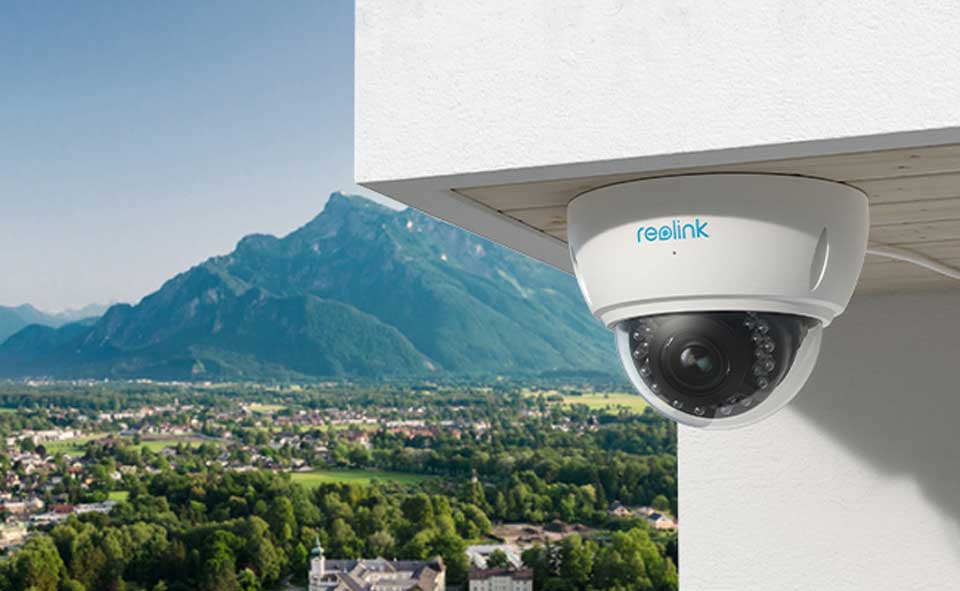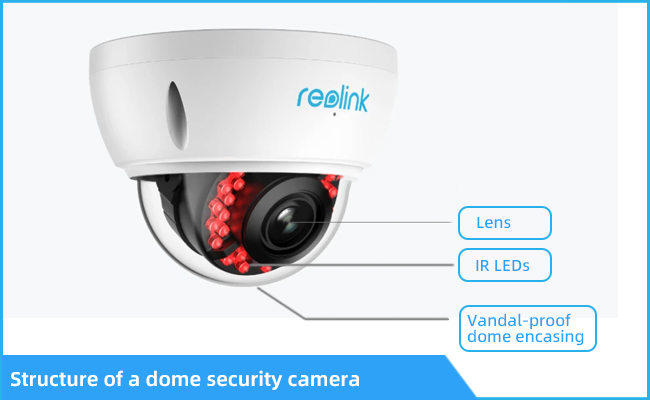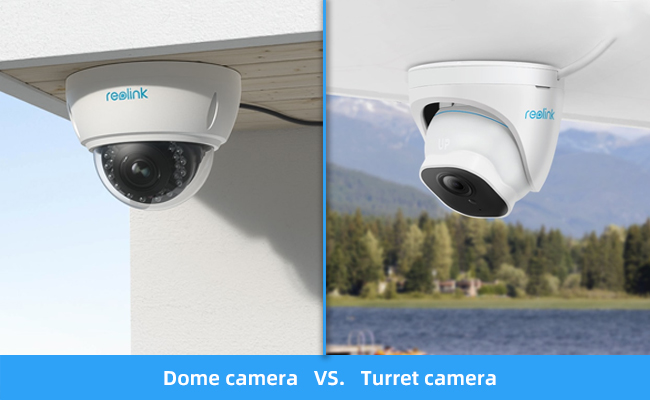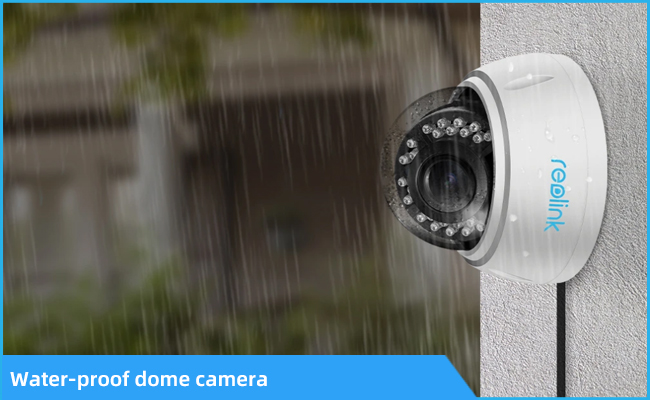Views: 9
Best Dome Cameras for Indoors and Outdoors: Pros, Types, Comparisons, and Best Picks
Best Dome Cameras security CCTV cameras are often seen in our everyday lives, including in shops, schools and many other places for security surveillance purposes. As a specific type of security camera, dome cameras are always compared to bullet cameras.
In this article we will share some insights on what a dome security camera is, its main benefits, how dome CCTV cameras compare to bullet security cameras and at the end we will give you our recommendations on the best dome security camera models.
- Definition
- Dome vs. Turret Cameras
- What are the Advantages of Dome Cameras?
- Different Types of Dome Camera
- Is the Dome Camera Good for Outdoor Use?
- Dome vs. Bullet Camera
- Best Picks for Dome Cameras
- What to consider
- FAQs
- Conclusion
Load More :
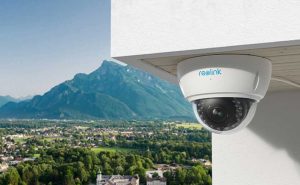
What Is A Dome Camera?
The definition of a dome camera
In most cases, a dome security camera is a camera with a dome shaped transparent cover. These security camera are encased in a transparent, protective cover. This cover helps to protect the camera from the outside world and also provides some protection against vandalism. Dome security cameras are typically used for indoor and outdoor applications.
Dome cameras get their name for the dome-shaped housings. These security cameras are designed to brave all the elements and provide reliable protection both indoors and outdoors.The special dome style with a rugged housing and other powerful features have made dome cameras an ideal choice for home or business owners.
The IK rating of a dome camera
The ruggedness of a vandal-proof dome camera depends on its IK rating, which ranges from IK00 to IK10. Dome cameras with an IK10 rating can survive up to twenty joules of impact, which is equal to being hit by a 5kg mass dropped from 40cm.
Here is a chart about IK rating for you to better understand it:
The special dome style with rugged housing and other powerful features have made dome cameras an ideal choice for home or business owners. They can be used both indoors and outdoors.
Usually, a dome camera is mounted upside down under the ceilings or eaves. Dome cameras can be used in a lot of places, including homes, retail stores, restaurants, schools, banks, construction sites, hospitals, and so on.
Dome Cameras or Turret Cameras, What’s the Difference?
The difference between dome cameras and turret cameras is that dome cameras have a transparent hemispherical cover, while turret cameras do not have a cover.
Turret cameras, also known as eyeball or planar cameras, are named after the armored gun turrets on military tanks. They are similar in appearance to dome cameras, but dome cameras have a hemispherical protective cover while turret cameras do not. Some camera brands or manufacturers classify turret cameras as dome cameras due to their dome-like shape.
Here is a comparison of dome cameras and turret cameras.
Sometimes people also regard turret cameras as a kind of dome cameras for their similar shape. And some manufacturers simply classify turret cameras under dome cameras for convenience. A quick tip to distinguish them is checking whether the lens is inside a clear cover.
What are the Advantages of Dome Cameras?
Besides their round shapes and adorable appearance, dome cameras have many other benefits that make them popular among users, and we have outlined the benefits of dome cameras and why you should buy one.
Dome cameras are durable and vandal proof
dome cameras are a type of security camera that is often used in high-security areas because they are very durable and vandal proof. dome cameras are designed to be tamper resistant so that they cannot be easily damaged or disabled. They are often used in public places like airports and government buildings where it is important to maintain a high level of security.
dome cameras are also popular in businesses and homes because they offer a high level of protection against theft and vandalism. dome cameras are usually more expensive than other types of security cameras, but their durability and vandal proof design make them worth the investment.
Dome cameras are Weatherproof & Water-Resistant
Dome cameras are weatherproof and water-resistant because of their design. The camera is enclosed in a dome-shaped cover, which protects it from the elements. The cover protects the camera from the elements and prevents it from getting wet. This makes dome cameras ideal for use in outdoor environments where there is a high risk of inclement weather. The cover also keeps dust and dirt from getting into the camera, which can damage it.
This also helps to keep the camera dry, even if it’s raining or snowing. Additionally, the camera is sealed so that no water can get inside. This makes the dome camera ideal for use outdoors, in all weather conditions.
Most outdoor dome cameras come with an IP rating, such as IP66 or IP67. It proves that the camera is capable to withstand harsh weather and can keep working in most conditions.
Dome cameras are low profile and less invasive
Dome cameras are designed to be low profile and less invasive, making them a popular choice for use in public areas. This cover hides the camera lens, making it difficult to see which direction the camera is pointing. This feature also makes the dome camera less conspicuous, which can be helpful in deterring potential thieves or intruders.
The dome camera is not easy to see the orientation of the security camera lens, and it is low invasiveness. The dome camera is mostly used in public places such as schools, hospitals, shopping malls and office buildings.The lens of a dome camera is mostly covered, making it not so noticeable and conspicuous. Looking from afar, you may hardly figure out which direction the dome camera is actually pointing.
This uncertainty can be a great help in deterring potential thieves or intruders. If people don’t know where the camera point, they’ll unconsciously think they’re being monitored and control their behavior. So, a dome camera is especially useful in places where people do not expect to be surveilled.
Dome cameras are highly adaptable for outdoor & indoor
dome cameras are one of the most popular types of security cameras on the market. dome cameras are highly adaptable and can be used indoors and outdoors in a variety of locations. dome cameras are typically made of high-quality materials that are weather resistant, making them ideal for outdoor use. dome cameras also have a wide field of view, making them perfect for monitoring large areas.
Additionally, dome cameras are easy to install and can be mounted on ceilings or walls. dome cameras are also relatively affordable, making them a great option for home and business owners alike.
Dome cameras have a compact Design
Dome security cameras come in different shapes and sizes to suit your needs. Dome camera has a simple and elegant design, which can be installed in any environment.
But the common part of dome cameras is that they all have a fixed or movable dome. With the compact design, you can put a dome camera under any ceiling or eave and make it blend into the environment.
Also, the less intrusive dome cameras are less likely to spoil the aesthetics of the house. White dome cameras are also more adaptable to different architectural styles or naturally immerse with decors.
Dome cameras have a great night Vision
Normally, dome security cameras can stand guard on your property both day and night, even in total darkness. In virtue of the built-in infrared LEDs, the outdoor dome cameras can deliver sharp and clear images without ambient light at all.
In the unfortunate case that you suffer from a home break-in, the dome-shaped security cameras would send you instant alerts and the recorded footage can also be the proof to help pinpoint suspects.
Different Types of Dome Camera
In the security camera market, dome cameras often include the following 3 types, each with its own special feature:
1. PoE Dome Camera
A PoE (Power-over-Ethernet) dome camera requires only one Ethernet network cable for data transmission and power supply.
PoE dome cameras are easy to install and use. No messy wiring is needed. Once you connect the PoE dome camera to the router with a CAT5 or CAT6 cable, you can see everything the camera captures from anywhere on your mobile devices.
2. PTZ Dome Camera
A pan-tilt-zoom (PTZ) dome camera can pan left to right, tilt up or down, and zoom in/out for all around views.
Since its lens can be adjusted to different angles, a PTZ dome camera can even see 360° with no blind spots. This extraordinary feature offers you the great convenience of monitoring a large open area, like your driveway, parking lots and front doors, in great detail.
High-quality PTZ dome cameras are able to move automatically between pre-set points once triggered by events. Some special auto-tracking PTZ cameras can even detect and follow people or vehicles within their range.
3. 4K Dome Camera
A 4K dome camera boasts 8 megapixels high resolution, which is nearly 4 times clearer than 1080p or 2MP. 4K dome cameras are becoming trending because they provide richer details as well as clearer images.
High resolution is one of the most important features of security cameras. A high-definition dome camera is more capable to show you real situations with more details and vivid colors. It can help you find out the thief with the evidence from the recordings.
Is the Dome Camera Good for Outdoor Use?
Yes, dome cameras can be used in both indoor and outdoor conditions. Outdoor dome cameras are specifically designed to withstand harsh weather conditions such as rain, snow, and extreme temperatures. They also provide a clear view of the area around them, which makes them ideal for securing properties.
Outdoor dome cameras are popular due to 4 main reasons:
- Durable & Water-proof Housing. Normally, an outdoor dome camera has a metal base and a sturdy cover. The base allows it to hang from ceilings or be mounted on walls. The cover is solid enough to withstand sunshine and rainstorms. The lens covered inside the housing is well protected and can work for a longer time.
- High Resolution. The resolution of an outdoor dome camera ranges from 1080p to 4K 8MP. High-resolution cameras will capture clear footage of everyone passing by. Face recognition will be easier from those HD recordings. This makes outdoor dome cameras perfect in high-traffic areas such as crossroads and school hallways.
- Day & Night Surveillance. Not only protect your assets during the day, but outdoor dome cameras also provide you peace of mind at night. The built-in infrared LEDs and quality image sensor combined together let you see what happens even in low-light conditions.
- Wide Angle. Outdoor dome cameras, particularly the PTZ ones, have a large field of view up to 180° or even 360°, overshadowing the majority of other bullet cameras on the market. The PTZ dome cameras can rotate horizontally and vertically and are ideal to monitor large and open areas such as parking lots.
Dome vs. Bullet Camera, Which Is Better?
A security camera is an important part of any home security system. There are two main types of security cameras: dome and bullet. Both have their pros and cons, so which one you choose will depend on your specific needs.
Dome cameras are round and typically sit on the ceiling. They are less visible than bullet cameras, and because the lens is hidden behind the dome, they are less likely to be damaged. However, they can be more expensive than bullet cameras.
Bullet cameras are shaped like bullets and can be mounted on walls or ceilings. They are more visible than dome cameras, but they are also cheaper. They also have a wider lens angle than dome cameras, making them better suited for covering large areas.
However, there does exist something different between a dome camera and a bullet camera. Here we compare these two types of cameras from 4 aspects. Keep reading and you’ll know how to make the right decision.
1. Durability and vulnerability
A dome camera is basically enclosed in a semi-circular housing. Some dome cameras have an extra transparent cover to better protect the lens. While a bullet camera has a simpler design that looks like the shell of a bullet with no extra protection.
Generally speaking, a dome camera is more durable and vandal-proof than a bullet camera for its sturdy cover. Also, the rounded shape of a dome camera leaves less possibility for burglars to break it with tools.
By comparison, a bullet camera is more vulnerable because its base and the lens belong to two parts. Determined intruders may throw chains up over the camera and put it down or climb up to tear it apart. That’s a real risk for homeowners.
Besides, birds tend to rest and nest on a bullet camera, which brings many problems. Birds may block the camera, or cause false detections on the camera’s sensor. This will make the camera less efficient.
So, if you’re going to put a camera where people can have access to it or you don’t want birds to affect the camera, you’d better choose a dome one.
2. Installation
Both dome and bullet cameras can be ceiling-mounted or wall-mounted. But as their designs are different, bullet cameras are less challenging to install than dome cameras.
A minor inconvenience of installing a dome camera is that once you’ve mounted it, it is not an easy task to reposition the camera. Most vandal-proof dome cameras can’t be adjusted. If you want to change its position for a different viewing angle, you may need to take the dome camera down and do the installation work over again.
Installing a bullet camera is much easier because the mounting handle can be adjusted. You can quickly mount the bullet camera to a wall and adjust its angle flexibly for a better view. Anyone can easily move the bullet camera into position or reposition it when necessary.
Bonus Tips: If you prefer a dome camera, don’t be frightened by its installation. Some dome cameras are not hard to install if you follow the correct guide. Here is a video showing how to set up and install a dome security camera. Even if you’re not a professional installer, you can do it nicely!

3. Long Range
Bullet cameras in a long form are capable to accommodate a larger lens than dome cameras do, which means they can have a longer range.
A bullet camera designed for looking at long distances can see 120ft and even further. Besides, it’s easy to equip a bullet camera with effective optical zoom due to its large size. If you want to monitor an area that is far away, a bullet camera is the best choice.
Dome cameras, on the other hand, have limited room for the lens, sensor, and other components. Even though their range is shorter, the viewing angle is wider. Thus, dome cameras are more suitable in wide and close areas, such as yards, halls, and other average properties.
4. Deterrence
Dome cameras have a lower profile than bullet cameras and work as a better deterrent.
The discreet style makes dome security cameras less intrusive and noticeable to people passing by. Also, it’s hard to find which direction the dome camera is really pointing. Burglars who want to take their chances will be unsure whether they are caught by the camera and stop the crimes in some cases.
Bullet cameras are totally different. They always stick out and draw people’s attention at first time. It is an obvious signal that the area is monitored. To some extent, bullet cameras can prevent bad behaviors.
But more often, trespassers see where a bullet camera points at and will find a blind spot. If you want to avoid such problems, you can install several cameras and try to cover all areas.
Finding Best Dome Cameras? Check Our Best Picks
With everything about dome cameras explained clearly above, now you’re prepared to get your dome camera. To save your time, we’ve picked several best dome cameras for you.
From its outlook, you’ll see how durable RLC-842A is. This dome camera comes with IP66 waterproof and IK10 vandal-proof housing. Neither harsh weather conditions nor hits from burglars won’t beat it down.
This vandal-proof dome camera can be installed anywhere – indoors and outdoors. It can give you more reliable protection while deterring tampering or vandalism.
It’s equipped with smart detection and will alert you when any person or vehicle gets close to your property. Moreover, it boasts 4K 8MP ultra high resolution and 5X optical zoom, which are great for you to enjoy flawless pictures and videos.
Below you can see a video taken by the Reolink RLC-842A 4K dome camera and how it performs in daylight. You can also observe the good video clarity and detail that come with the high resolution.

Incredible 4K 8MP Video Captured by RLC-842A in the Daytime
Best WiFi Indoor/Outdoor Dome Camera –
As a wireless dome camera, Reolink RLC-542WA can be easily installed inside and outside your house without messy cabling. It is also IK10 vandal-proof and can stay safely in high-traffic places.
RLC-542WA supports both 2.4 GHz and 5 GHz frequencies to ensure better performance for camera networking. It can record 24/7 and never miss a thing. 24 IR LEDs ensure good night vision quality.
Besides dome cameras, other types of cameras without a cover have their benefits and can also be a good choice for your home security system. Here are some of the best cameras.
Best Affordable Turret Camera
Although turret cameras do not have a dome-shaped cover, some brands and manufacturers will also classify them as dome cameras, so we will also recommend turret cameras in this section.
RLC-520A is the best budget-friendly choice for those who want a discreet camera in their front doors or stores.
This smart security camera has all the basic features you need: person/vehicle detection with no subscription fees, 5MP high resolution, IR night vision, and so on. More importantly, it’s much easier to install and you can manually adjust its angle anytime.
What to consider you Before Buying A Dome Camera?
There are so many dome cameras in the market with different features and prices, and you may hesitate to choose one. Don’t worry. Answer the following questions and you’ll know what dome camera to buy.
Are you using a dome security camera indoors or outdoors?
If you need a dome camera inside your house, you can choose a simple model with basic functions: 1080p or higher resolution, infrared night vision, motion detection, and so on.
But if you want to use it outside your house, you must consider its durability. An outdoor dome camera with weather-proof and vandal-proof capabilities is your best choice. It should have an IP65 or IP66 rating to withstand the outdoor environment.
How many dome cameras do you need?
The number of dome cameras depends on where you want to monitor. If it’s a large area such as parking lots and crossroads, you should choose a PTZ dome camera for a wide viewing angle. Or you can buy several dome cameras and put them in different places.
For what kind of environment or working scenario will you use the dome camera?
Will harsh weather occur frequently in your area? Will it be extremely hot or cold?
If so, you should care about the working temperature of the dome camera besides its IP rating. You can check the specification on the manufacturer’s website or ask the support before purchasing a dome camera.
Many outdoor dome cameras normally works in temperature ranging from 14°F to 131°F (-10˚c – +55˚c) with the humidity level around 10%~90%. If the ambient temperature exceeds this range, you should take other measures, such as using an additional rain cover or enclosure to protect the camera.
FAQs
Can dome cameras see 360?
Yes, dome cameras can see 360 degrees. This is due to the ability of the camera to rotate around its axis. Additionally, many dome cameras have the ability to tilt up and down, which gives even greater viewing range.
A PTZ dome camera can see in all directions, allowing for a full 360° view without any blind spots. This type of camera can rotate left to right or up and down, making it perfect for monitoring a large area. Additionally, many PTZ cameras have the ability to automatically track people or vehicles, making it easy to keep an eye on everything happening in the scene.
How far can a dome camera see?
The range of dome security cameras varies due to different focal lengths, resolutions, and quality. Generally speaking, a dome camera can see in a range between 20 – 70ft. If you want to see further, you can choose professional cameras designed for long-range surveillance.
Conclusion
Dome cameras are good to use both indoors and outdoors for their many benefits. Such a security camera helps a lot in building home security systems.
From this article you’ve learned how to choose the best one for your home. Now it’s your turn. Leave a comment below and share your ideas about dome cameras, how you use them, and any related experience!
Source : Reolink
